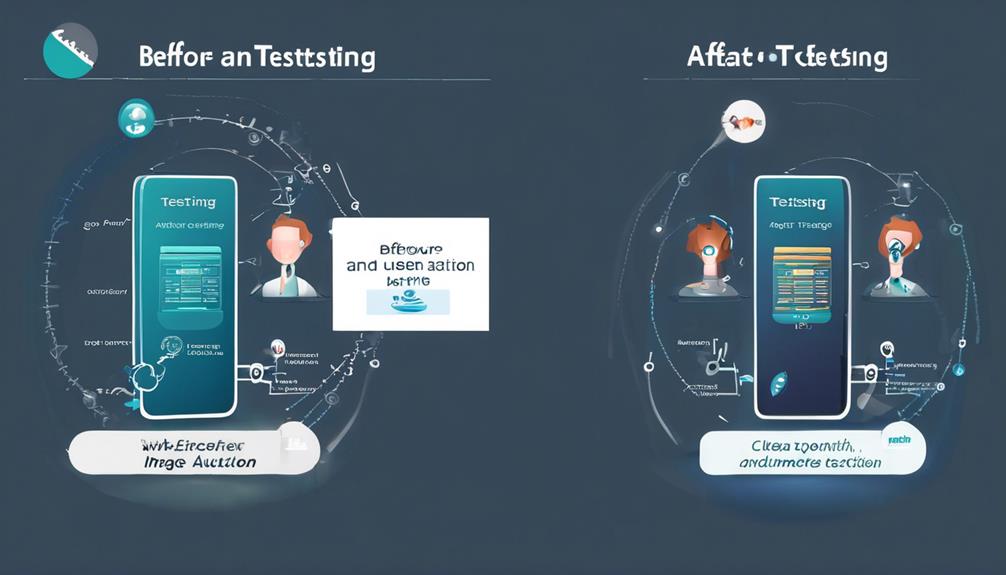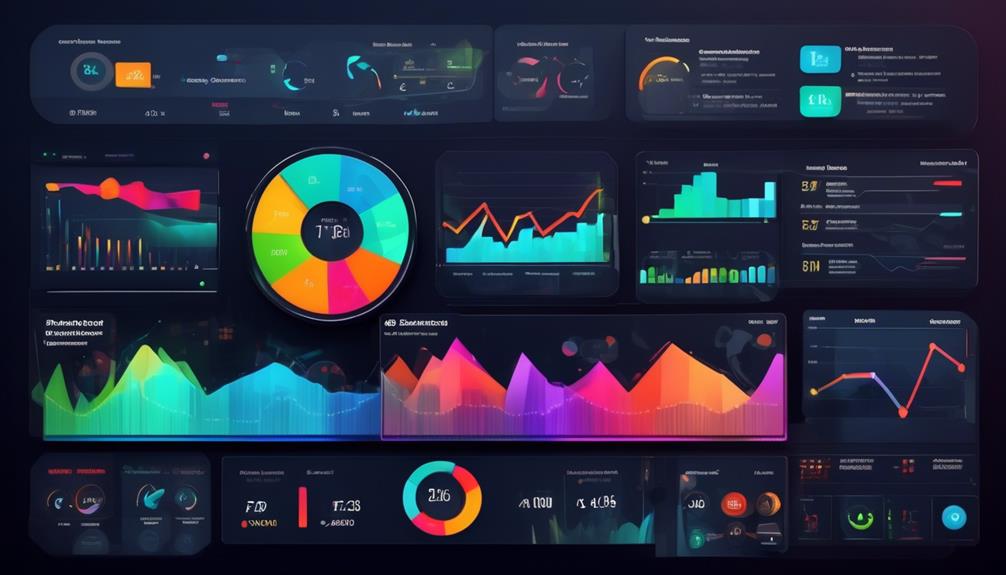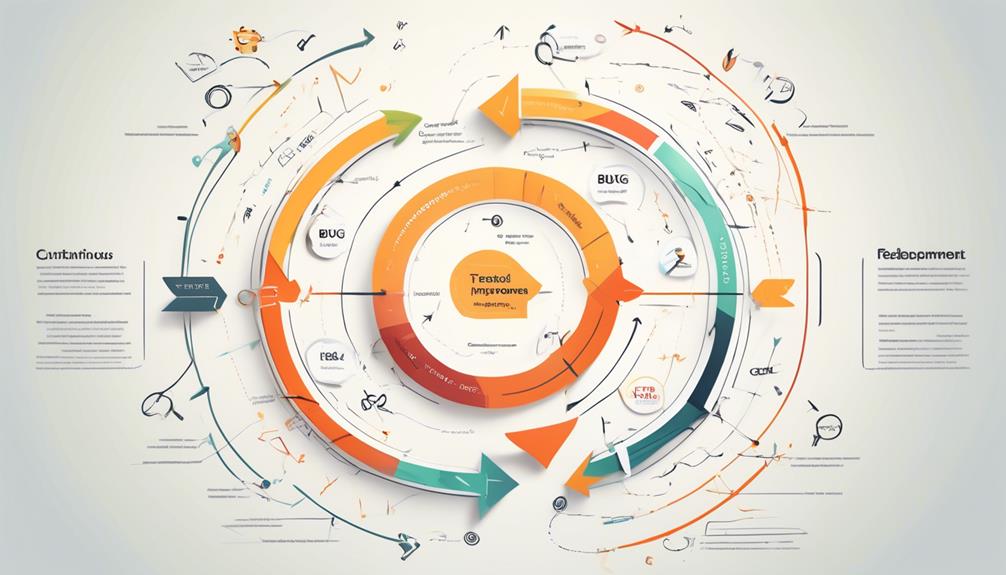As Quality Assurance professionals, we are always at the crossroads of innovation, continuously striving to improve our techniques and outcomes. This continuous quest for improvement reflects the commitment of a talented artist honing their skills to create masterpieces.
We all strive for QA success, and in this ever-evolving landscape, there are nine key tactics that can pave the way for us to achieve it. These tactics are not just theoretical concepts but practical strategies that have the potential to transform our approach to quality assurance.
Each tactic holds the promise of enhancing our effectiveness, elevating the quality of software, and ultimately contributing to the success of our organizations.
Key Takeaways
- Root cause analysis techniques such as the ‘5 Whys’ approach and fishbone diagrams are essential for uncovering the underlying reasons behind issues or defects.
- Test automation should be viewed as an ongoing process of continuous improvement, with strategic selection of tests and clear communication between developers and testers.
- Defect management should involve identifying, reporting, prioritizing, and tracking defects throughout the development lifecycle, and integrating defect management with quality management practices.
- Performance monitoring allows for real-time tracking and analysis of software performance metrics, proactively addressing performance issues, and making informed decisions to improve software performance.
Root Cause Analysis Techniques
Root cause analysis techniques provide a systematic approach for uncovering the underlying reasons behind issues or defects in the software development process, enabling proactive and data-driven problem-solving. These methods, including the ‘5 Whys’ approach, fishbone diagrams, fault tree analysis, and Pareto analysis, allow us to dig deeper into the causes of problems. By utilizing these techniques, our QA teams can identify systemic issues rather than just addressing surface-level symptoms, leading to more effective and long-term solutions. This approach is crucial for preventing recurring problems, improving overall software quality, and enhancing customer satisfaction.
Moreover, root cause analysis techniques empower us to make data-driven decisions, prioritize improvement efforts, and drive continuous enhancement in our QA processes. By delving into the root causes of issues, we can establish meaningful performance metrics, track the effectiveness of our quality improvement initiatives, and ensure that our software development process is constantly evolving for the better.
Ultimately, these techniques are instrumental in fostering a culture of continuous improvement, where proactive identification and resolution of underlying issues lead to enhanced software quality and a more robust development process.
Test Automation Implementation

Implementing test automation builds upon the foundational principles of root cause analysis techniques, enabling us to efficiently identify and automate the most challenging areas of manual test execution.
When approaching test automation implementation, it’s essential to consider the following:
- Collaboration between Developers and Testers: Effective test automation requires collaboration between developers and testers. Both parties should contribute to the process, ensuring that the automation effort aligns with the software testing process and quality assurance (QA) standards.
- Continuous Improvement: Test automation should be viewed as an ongoing process that aligns with the principles of continuous improvement. Regular assessments of the testing tools, measurement of performance indicators, and adjustments based on the results are essential for maintaining the effectiveness of automation.
- Strategic Selection of Tests: It’s crucial to discern when to automate tests and when not to. Prioritizing tests based on their significance, complexity, and frequency of execution is vital for maximizing the benefits of test automation.
- Effective Communication: Clear and open communication between teams is paramount for successful test automation implementation. This ensures that everyone involved understands the objectives, progress, and potential challenges, fostering a collaborative and proactive approach to QA success.
Effective Defect Management
In our pursuit of maintaining high-quality software, we prioritize efficient defect management processes. This involves identifying, reporting, prioritizing, and tracking defects throughout the software development lifecycle.
Effective defect management is essential for continuous improvement in QA. It ensures that defects are proactively prevented and efficiently resolved to minimize impact on project timelines.
Utilizing defect management tools and technologies can streamline the defect tracking process, improve visibility, and enable quicker issue resolution.
Regular analysis of defect data and metrics is crucial for identifying trends, root causes, and areas for improvement in the defect management process.
By integrating defect management with quality management practices, we can enhance the overall testing process and strengthen communication between development and QA teams.
Performance indicators related to defect management, such as defect density and defect removal efficiency, provide valuable insights into the effectiveness of our quality assurance efforts.
Through a proactive approach to defect management, we can uphold high standards of software quality and contribute to the success of the overall software development lifecycle.
Continuous Performance Monitoring

Continuous Performance Monitoring is an essential practice that enables real-time tracking and analysis of software performance metrics to promptly identify and resolve issues. It allows for proactive identification of performance bottlenecks and helps in maintaining a high level of system reliability and responsiveness.
Through continuous monitoring, performance is consistently measured, analyzed, and optimized throughout the software development life cycle. This proactive approach ensures that potential issues are addressed before they impact the end-user experience, thereby contributing to overall system stability and scalability.
Additionally, Continuous Performance Monitoring plays a vital role in maintaining the overall health of the software application by providing valuable insights into the system’s performance. This data-driven approach allows organizations to make informed decisions to improve software performance and enhance user experience.
Agile Testing Methodologies
Utilizing Agile testing methodologies allows us to emphasize iterative and incremental testing throughout the development lifecycle, promoting collaboration and communication among developers, testers, and business stakeholders to deliver high-quality software quickly and adapt to changing requirements.
Agile testing focuses on continuous improvement in software testing, enabling teams to respond swiftly to evolving customer needs. Test automation plays a pivotal role in Agile testing, as it facilitates rapid and continuous testing, ensuring that the product meets quality standards within shortened development cycles.
Continuous integration and continuous delivery (CI/CD) practices are integral in Agile testing, enabling seamless integration, testing, and deployment of changes.
Agile testing methodologies also emphasize the importance of close interaction between cross-functional teams, fostering a shared understanding of project goals and requirements. This collaborative approach allows professionals to address issues in real-time, leading to improved products and reduced time to market.
Enhanced Test Data Management

As we explore Enhanced Test Data Management, it’s crucial to consider the key elements of data masking, data subsetting, and data generation.
These tactics play a pivotal role in ensuring that test data isn’t only comprehensive but also secure and privacy-compliant.
Data Masking
To ensure the security and compliance of sensitive information in software testing, data masking, also known as enhanced test data management, involves altering original data to create realistic test data while protecting confidential data.
When implementing data masking as part of the continuous improvement in QA, professionals effectively work towards testing and process improvement.
Measurement: Implement metrics to track the effectiveness of data masking in QA improvement.
Communication Between Test and Development Teams: Establish clear channels for communicating the requirements of data masking and its impact on the test process.
Identifying the Data Sets: Define the specific data elements that require masking to ensure comprehensive coverage.
Ultimately, data masking contributes to a greater quality management plan by enabling accurate testing while safeguarding sensitive information.
Data Subsetting
Enhancing test data management through the practice of data subsetting involves creating smaller, representative subsets of production data to improve the efficiency and accuracy of testing processes. By reducing data volumes while maintaining data characteristics, teams can ensure that test environments closely mimic production environments. This is crucial in an active product development cycle, where continuous improvement in software quality is essential. The right testing tools, combined with enhanced test data management techniques like data subsetting, enable effective manual test execution and accurate test cases. To convey the deeper meaning of data subsetting, consider the following table:
| Benefits of Data Subsetting |
|---|
| Efficient Testing Processes |
| Secure Handling of Sensitive Data |
| Quality Enhancement |
| Mimicking Production Environments |
| Reduced Data Volumes |
Data Generation
In our pursuit of enhanced test data management, we prioritize the meticulous creation of both negative and positive test cases during test scenario development. To achieve this, we focus on the following tactics:
- Identifying data sets early in the test design phase
- Ensuring the system verification plan includes multi-threaded tests and straightforward function verification checks
- Integrating automated testing into the test data management process
- Collaborating with developers and testers to contribute to the test automation process
Robust Test Environment Setup

We ensure our test environment is stable and replicable to consistently produce accurate results.
We focus on resource scalability to accommodate varying testing requirements and workloads.
Environment Stability
To ensure stability and reliability for conducting software testing activities, a well-planned and properly configured test environment is essential. When focusing on environment stability, several key factors contribute to achieving this goal:
- Continuous monitoring and maintenance of the test environment
- Efficient communication between teams to ensure the components of a test are properly integrated
- Quality management and test execution phase to assess software quality
- Skill development to ensure the testing process is progressing effectively
Maintaining a stable test environment minimizes the risk of false positives or false negatives in test results, allowing for efficient test execution and accurate assessment of software quality.
Continuous improvement in QA is facilitated by feedback, which ensures that the testing process remains effective and reliable.
Resource Scalability
When designing a robust test environment setup, it’s imperative to prioritize resource scalability to effectively accommodate fluctuating testing needs and demands.
Continuous improvement in QA necessitates constantly seeking efficient and effective ways to manage resources. Embracing the Kaizen philosophy, QA remains proactive in ensuring the scalability of the testing environment.
This involves frequent communication between teams to assess resource availability and project requirements. Implementing strategies such as virtualization, containerization, and utilizing cloud-based infrastructure enables dynamic scaling of the test environment based on workload and testing demands.
Quality control and system verification are upheld through the regular assessment and updating of the test environment setup to align with evolving project requirements and resource availability. Prioritizing resource scalability ensures the efficiency and effectiveness of the testing process, ultimately contributing to QA success.
Quality Metrics and KPIs

Quality metrics and key performance indicators (KPIs) play a crucial role in providing actionable insights for improving testing efficiency and effectiveness. When it comes to Continuous Improvement in QA, tracking KPIs over time is essential to gauge the success or failure of implemented changes in the testing process.
To ensure that project deliverables meet the acceptable level of product quality, it’s crucial to assess the quality using a variety of KPIs. These include test coverage and test automation coverage, which are vital for ensuring thorough testing and consistent quality. Defect density, test efficiency, and test effectiveness are also important KPIs for evaluating code quality and the effectiveness of testing processes.
As market changes occur, these metrics help in adapting testing strategies to maintain a high-level scenario. Additionally, using testing tools based on these metrics can lead to a better return on investment, as they provide insights into areas where improvements are needed, ultimately leading to higher quality products and more efficient testing processes.
Feedback Loop Optimization

Gauging the success or failure of implemented changes in the testing process through tracking KPIs over time, we now shift our focus to optimizing the feedback loop for continuous improvement in QA. A well-optimized feedback loop is crucial for enhancing the quality of the software and the overall efficiency of the development process. To achieve this, it is essential to establish effective communication channels between teams, select appropriate quality metrics, and continuously refine the test design. The table below outlines key strategies for optimizing the feedback loop in QA.
| Optimization Strategy | Description | Benefits |
|---|---|---|
| Stakeholder Involvement | Engage stakeholders at every stage of the test phase to gather diverse feedback and improve the product quality. | Enhanced product alignment with user expectations |
| Root Cause Analysis | Conduct thorough analysis to identify underlying issues, prevent recurring problems, and drive continuous improvement. | Reduction in defect recurrence and improved overall product quality |
| Data-Driven Decisions | Utilize metrics and KPIs to make informed decisions, measure effectiveness, and drive improvements in the QA process. | Enhanced decision-making based on real-time feedback |
| Skills Development | Invest in training and skill development for QA professionals to enhance their ability to provide and utilize feedback. | Improved effectiveness and efficiency in the feedback loop |
| Continuous Improvement Practices | Implement improvement strategies such as Kaizen philosophy, process automation, peer reviews, knowledge sharing, and retrospectives. | Sustained enhancement of the feedback loop and overall QA process |
Optimizing the feedback loop is a proactive practice to start, as it ensures that the QA process continuously evolves to meet the dynamic demands of software development. By adopting these strategies, organizations can drive continuous improvement in QA, leading to higher levels of product quality and customer satisfaction.
Frequently Asked Questions
What Is Continuous Improvement in Qa?
Continuous improvement in QA involves consistently identifying and implementing small changes to enhance software testing processes. It focuses on ongoing enhancement, measuring effectiveness, and ensuring software quality and efficiency.
We continuously seek areas for improvement, implement changes, and measure their impact. This approach is vital for achieving sustained success in software testing. It’s a proactive and analytical strategy that emphasizes ongoing enhancement and adaptation within QA processes.
What Are the 4 Steps of Continuous Quality Improvement?
The four steps of continuous quality improvement involve:
- Setting objectives
- Collecting and analyzing data
- Implementing improvements
- Monitoring results
What Are the 5 Key Principles of Continuous Improvement?
We believe the five key principles of continuous improvement are:
- Setting clear objectives
- Monitoring progress
- Identifying areas for improvement
- Implementing changes
- Evaluating results
These principles create a structured approach to ongoing development, ensuring that processes and products continually evolve and optimize.
How Can QA Process Be Improved?
We can improve the QA process by implementing efficient quality assurance standards and management to ensure high-quality software.
Developing a testing plan that complies with business requirements and specifies a clear level of product quality is crucial.
We also need to identify and automate the most challenging regions during manual test execution to enhance automated testing.
Selecting appropriate QA tools and integrating them with other tasks can further improve the QA process.
Conclusion
In conclusion, the implementation of these continuous improvement tactics for QA success has proven to be essential for our team.
We’ve seen significant progress in our quality assurance processes and are eager to see the continued impact on our software quality and customer satisfaction.
Stay tuned for more updates on our journey towards excellence in QA.
Randy serves as our Software Quality Assurance Expert, bringing to the table a rich tapestry of industry experiences gathered over 15 years with various renowned tech companies. His deep understanding of the intricate aspects and the evolving challenges in SQA is unparalleled. At EarnQA, Randy’s contributions extend well beyond developing courses; he is a mentor to students and a leader of webinars, sharing valuable insights and hands-on experiences that greatly enhance our educational programs.










